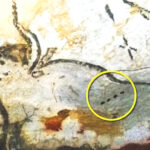Enceladus, the sixth-biggest moon of Saturn, is a top candidate in the search for extraterrestrial life in the Solar System.

An artist’s impression of NASA’s Cassini spacecraft flying through plumes erupting from the south pole of Enceladus; these plumes are much like geysers and expel a combination of water vapor, ice grains, salts, methane and other organic molecules. Image credit: NASA / JPL-Caltech.
In 2014, NASA’s Cassini spacecraft discovered evidence of a large subsurface ocean on Enceladus and sampled water from geyser-like eruptions that occur through fissures in the ice at the south pole.
The robotic probe detected methane and other organic molecules that build the foundations of life.
In 2021, University of Arizona planetary scientist Régis Ferrière and colleagues calculated that if alien life could have emerged on Enceladus, there is a high likelihood that its presence could explain why the moon is burping up methane.
“To know if that is the case, we must go back to Enceladus and look,” Dr. Ferrière said.
In their new paper, Dr. Ferrière and co-authors report that while the hypothetical total mass of living microbes in Enceladus’ ocean would be small, a visit from an orbiting spacecraft is all that would be needed to know for sure whether Earthlike microbes populate Enceladus’ ocean underneath its shell.
“Clearly, sending a robot crawling through ice cracks and deep-diving down to the seafloor would not be easy,” Dr. Ferrière said
“More realistic missions have been designed that would use upgraded instruments to sample the plumes like Cassini did, or even land on the moon’s surface.”
The excess methane Cassini detected in the plumes conjures images of extraordinary ecosystems found in the lightless depths of Earth’s oceans: hydrothermal vents.
Here, at the edges of two adjacent tectonic plates, hot magma below the seafloor heats the ocean water in porous bedrock, creating ‘white smokers,’ vents spewing scorching hot, mineral-saturated seawater.
With no access to sunlight, organisms depend on energy stored in chemical compounds released by the white smokers to make a living.
“On our planet, hydrothermal vents teem with life, big and small, in spite of darkness and insane pressure,” Dr. Ferrière said.
“The simplest living creatures there are microbes called methanogens that power themselves even in the absence of sunlight.”

This graphic illustrates how Cassini scientists think water interacts with rock at the bottom of Enceladus’ ocean, producing hydrogen gas. Image credit: NASA / JPL-Caltech / Southwest Research Institute.
Methanogens convert dihydrogen and carbon dioxide to gain energy, releasing methane as a byproduct.
The authors modeled its calculations based on the hypothesis that Enceladus has methanogens that inhabit oceanic hydrothermal vents resembling the ones found on Earth.
In this way, they calculated what the total mass of methanogens on Enceladus would be, as well as the likelihood that their cells and other organic molecules could be ejected through the plumes.
“We were surprised to find that the hypothetical abundance of cells would only amount to the biomass of one single whale in Enceladus’ global ocean,” said Dr. Antonin Affholder, a postdoctoral researcher at the University of Arizona.
“Enceladus’ biosphere may be very sparse. And yet our models indicate that it would be productive enough to feed the plumes with just enough organic molecules or cells to be picked up by instruments onboard a future spacecraft.”
The possibility that actual cells could be found might be slim, because they would have to survive the outgassing process carrying them through the plumes from the deep ocean to the vacuum of space — quite a journey for a tiny cell.”
Instead, the researchers suggest that detected organic molecules, such as particular amino acids, would serve as indirect evidence for or against an environment abounding with life.
“Considering that according to the calculations, any life present on Enceladus would be extremely sparse, there still is a good chance that we’ll never find enough organic molecules in the plumes to unambiguously conclude that it is there,” Dr. Ferrière said.
“So, rather than focusing on the question of how much is enough to prove that life is there, we asked, ‘What is the maximum amount of organic material that could be present in the absence of life?’”
If all measurements were to come back above a certain threshold, it could signal that life is a serious possibility.
“The definitive evidence of living cells caught on an alien world may remain elusive for generations,” Dr. Affholder said.
“Until then, the fact that we can’t rule out life’s existence on Enceladus is probably the best we can do.”
The study was published in the Planetary Science Journal.
_____
Antonin Affholder et al. 2022. Putative Methanogenic Biosphere in Enceladus’s Deep Ocean: Biomass, Productivity, and Implications for Detection. Planet. Sci. J 3, 270; doi: 10.3847/PSJ/aca275


